- Broadcasting
is sending a message to
all nodes in the network
- ( Broadcasting is a
special case of
multicasting)
- We have seen the
flooding technique
(see: click here)
which is a
(routing) table-less
Broadcasting technique
- Here, we study a MORE efficient broadcasting techique that uses information in routing tables
- The technique that we will study is called
Reverse Path Broadcasting
It is based on the idea of a Reverse Path Tree that spans all nodes in the network.
- So what the heck is a reverse tree ???
To understand this, let's look at the forward tree first....
- The FORWARD Tree
-
The forward tree
rooted at a node X consists of:
-
all shortest path
from X
to all other nodes.
- Example:
- The following figure shows a network of 5 nodes
- Notice that the link costs are NOT
symmetric
- At the bottom, there are 5 smaller figures
and each figure shows
the shortest paths
from a certain node (A. B, C, D or E)
to all other nodes in the network:

(NOTE: the paths are contructed by "reading" the routing tables)
- The following figure shows a network of 5 nodes
- The REVERSE Tree
-
The reverse tree
rooted at a node X consists of:
-
all shortest path
from all other nodes
to X
- Example:
- The following figure shows the same network of 5 nodes.
- At the bottom, there are 5 smaller figures and each figure shows the shortest paths from all other nodes in the network to a certain node (A. B, C, D or E)

(NOTE: the paths are contructed by "reading" the routing tables)
NOTE: The reserve tree and the forward tree can be different !!!
(Compare the reverse and forward tree of node A)
- The following figure shows the same network of 5 nodes.
- NOTE:
-
Some paths in
the REVERSE tree
of node X
MAY NOT
be
the minimum cost paths
form X to other nodes !!!
- If
link costs are ASYMMETRIC
,
then the forward tree of node X is (generally speaking)
not equal to the reverse tree !!!
The paths from node X to (all) other nodes in a forward tree is always minimum cost paths
The paths from node X to other nodes in a reverse tree may NOT be minimum cost paths
- If
link costs are SYMMETRIC
,
then the forward and reverse trees are
equal
(In other words, then paths from node X to other nodes in a reverse tree are also minimum cost paths
- Example:
- Forward trees with SYMMETRIC Costs:

- Reverse tree with SYMMETRIC Costs:

The forward and reverse trees are equal....
- We have seen that the flooding
method uses an
excessively large number
of messages to perform the broadcasting operation.
- Broadcasting must reach
all nodes in the network
- In order to do broadcast from a source node X,
we need a
tree
that is rooted at the source node X
- Example: Suppose node A wants to broadcast messages
to all nodes in this network:
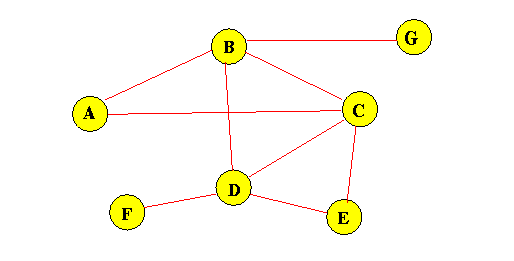
A can send messages along these blue edges to reach all nodes (broadcast = send to all nodes)

A can also send messages along these blue edges to reach all nodes:

In both cases, the edges form a tree rooted at node A
- How does node A broadcast
using a tree:
-
When a node in the network receives a
broadcast message from A
from the parent node
in the tree,
the node
forward the message to
all its children in the tree
(The parent node is the next node in the tree towards the root of the tree)
- Example:

When node B receives a broadcast message on link AB, node B will forward it on links BD and BG.
NOTE:
-
Broadcast messages from A will
never
arrive at B on any link other than
AB
So if B receives a broadcast messages from A through link BD, B can safely ignore it
- Bottomline:
In order to perform a broadcast operation using a tree, each node:
- must be able to determine
its parent node in the tree
(because broadcast messages always come from the parent node)
- in a lesser importance:
be able to determine
its children nodes in the tree
(This is not that crucial... worst comes to worst, you just send it to every node - except to the incoming node)
- must be able to determine
its parent node in the tree
(because broadcast messages always come from the parent node)
- Well-known Fact:
-
A broadcast operation from a node X
that sends messages
along
the edges of the tree rooted at X (to reach all other nodes)
will use the
minimal number
of messages
- Notice that the broadcast operation can use any tree
and it will use the
minimal number
of messages ...
If the forward tree is used, then messages will traverse the fastest route to every destination
(The previous statement is not true for the reverse tree)
- Facts:
- The information on "which node
is the parent"
in the forward tree
is very difficult to find
using information from the routing tables.
- Surprisingly, the information on "which node is the parent" in the reverse tree is very ESAY to find using information from the routing tables.
- The information on "which node
is the parent"
in the forward tree
is very difficult to find
using information from the routing tables.
- That's why this technique is called reverse tree broadcasting
- Dalal and Metcalfe discovered that the
(unicast) routing information
(i.e., entries in the routing table)
encodes the
reverse tree....
- To help you rediscover this, consider:
- the reverse tree
rooted at the node A in following network, and
- the content of the unicast routing table that are used to forwards packets towards node A:
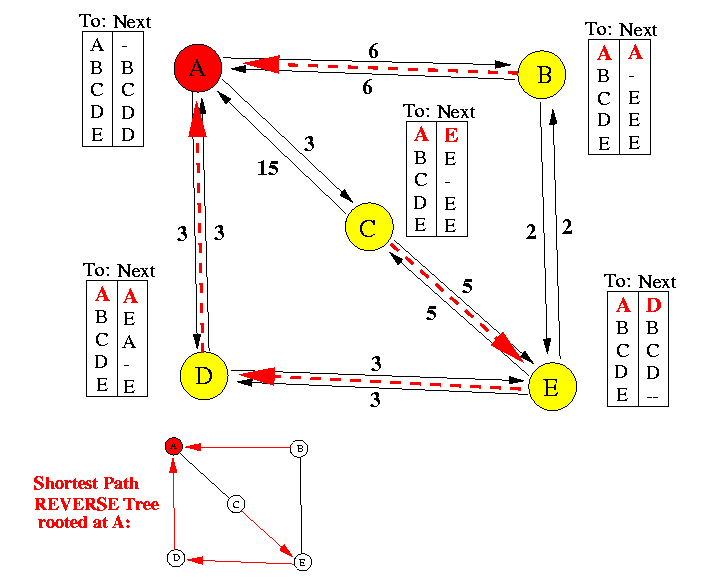
- the reverse tree
rooted at the node A in following network, and
- Notice that
each node
can tell
its parent node in the reverse tree
using the information in the
routing table:
- The parent node of B in A's reverse tree is A
- The parent node of C in A's reverse tree is E
- The parent node of D in A's reverse tree is A
- The parent node of E in A's reverse tree is D
All you have to do is to look at the Next field for the entry where destination = A
- In the 1978 paper, Dalal and Metcalfe developed
an efficient broadcast method that makes use
of the reverse path tree
This method is known as Reverse Path Broadcasting (RPB).
Since the reverse tree spans all nodes in the network, their method will broadcast...
- At the end of their 1978 paper, they mentioned that their method could be extended for multicast. And indeed, in 1993, Steve Deering extended their method to multicast.
- The basic underlying technique to implement reverse path broadcasting
that uses no additional information other than
unicast routing tables is:
-
When a node X receives a (broadcast) message from A,
it transmits the (broadcast) messages on
all its other links
(except on the incoming link)
if and only if the (broadcast) message
was received
on the link that X uses
to forward unicast messages to A.
- Consider the network in the above figure....
- Suppose node A sends a broadcast message
with header information: (To:ALL, From:A)
- This message is forwarded by the basic Reverse Path Forwarding principle
as follows:
- Node A sends the broadcast message:

- Notice that node A has no information available about the reverse tree
rooted at A !!!
- Therefore, it must send the message to all its neighbors to ensure that
- Note that the messages is FROM A and has the source ID = A, this is important for the next steps.
- Notice that node A has no information available about the reverse tree
rooted at A !!!
- Nodes B, C and D receive A's message. The following figure depicts
what each nodes will do with the received message (explanation
is given below the figure):
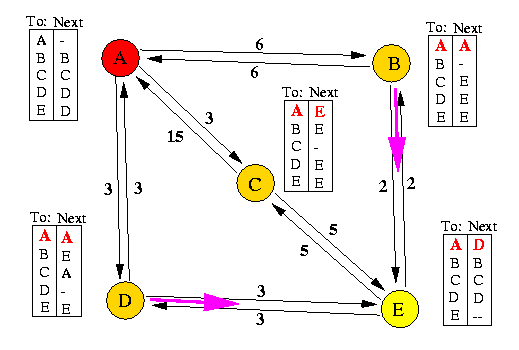
- When B receives the message, it can detect that the source ID = A
- Then B checks if the messages was received on the link it uses
to transmit to A. It did. So B forwards the message onto
its other links
- C receives the message from A, it can detect that the source ID = A
- Then C checks if the messages was received on the link it uses
to transmit to A. It did not (C uses E to forward to A).
So C drops message from A.
- When D receives the message, it can detect that the source ID = A
- Then D checks if the messages was received on the link it uses to transmit to A. It did. So D forwards the message onto its other links
- Nodes E receives B's and D's messages. The following figure depicts
what E will do with the received messages (explanation
is given below the figure):

- E receives the message from B, it can detect that the source ID = A
- Then E checks if the messages was received on the link it uses
to transmit to A. It did not (E uses D to forward to A).
So B drops message from B.
- E receives the message from D, it can detect that the source ID = A
- Then E checks if the messages was received on the link it uses to transmit to A. It did. So E forwards D's message onto its other links
- Nodes C receives E's messages. The following figure depicts
what C will do with the received messages (explanation
is given below the figure):
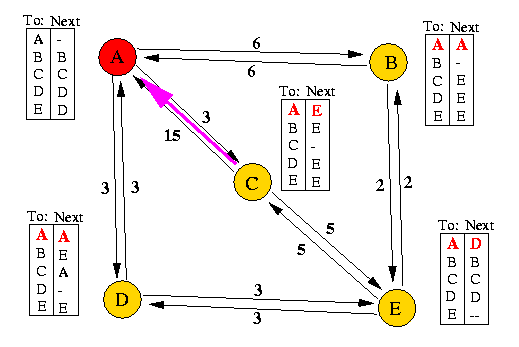
- C receives the message from E, it can detect that the source ID = A
- Then C checks if the messages was received on the link it uses to transmit to A. It did. So C forwards E's message onto its other links
Bottom line: every node receives the messages from A.... albeit not as efficient (yet) as it should... that will change with some improvement....
- Node A sends the broadcast message:
|
- There is a saying that
Finding what is wrong is is half of the solution
- What is wrong with the basic approach:
-
Although a node
can correctly identify its
parent node
of the tree (for a node X),
a node
CANNOT identify
its children nodes
of the tree...
- Solution:
-
Very simple...
Because each node can correctly identify its parent node of the tree (for a node X), the node can tell its parent node that it's a child node of the tree for a node X
- B's routing table is:
To | Next -------+-------- A | A B | - C | E D | E E | E - B will send:
- "I'm your child of tree(A)" to A
- "I'm your child of tree(C)" to E
- "I'm your child of tree(D)" to E
- "I'm your child of tree(E)" to E
- Example processing:
(we focus on message that are relevant to the tree rooted at A)
- B sends "I (B) am your child of tree(A)" to A:
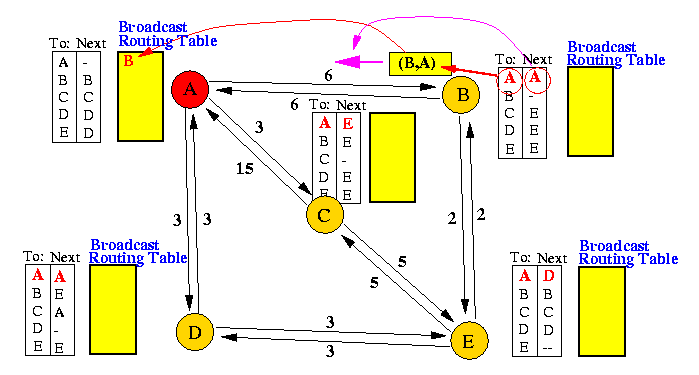
Result: A enters B into the broadcast table for entry A
- C sends "I (C) am your child of tree(A)" to E:
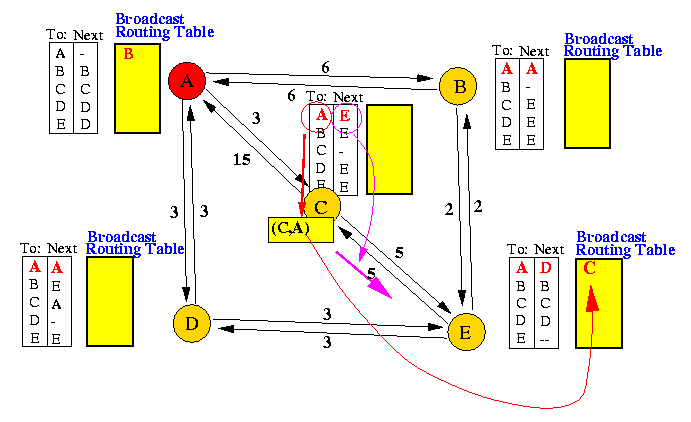
Result: E enters C into the broadcast table for entry A
- D sends "I (D) am your child of tree(A)" to A:
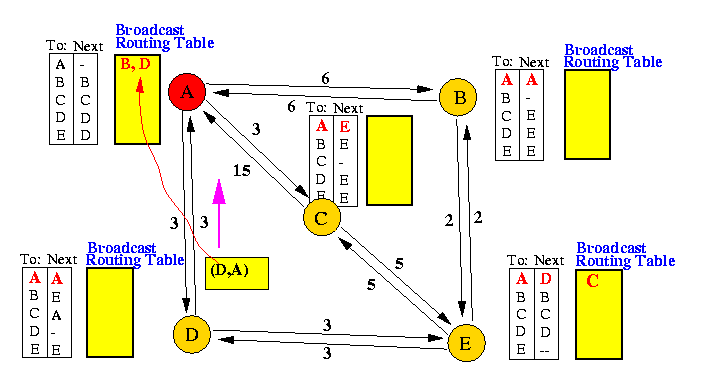
Result: A enters D into the broadcast table for entry A
- E sends "I (E) am your child of tree(A)" to D:
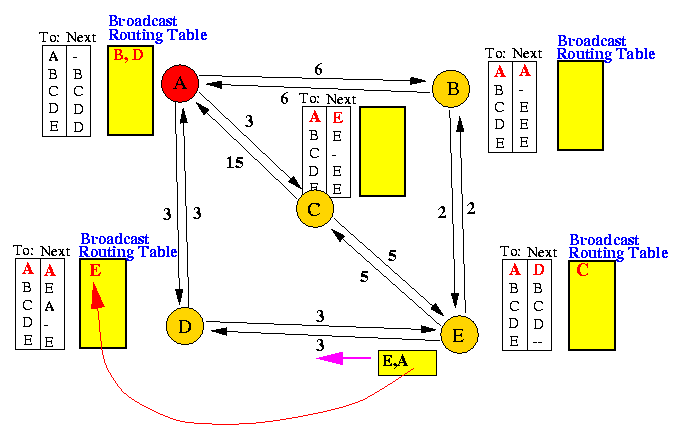
Result: D enters E into the broadcast table for entry A
- B sends "I (B) am your child of tree(A)" to A:
- Final Result:

The broadcast routing tables clearly shows that broadcast messages from A will follow the reverse tree and it uses the minimum number of messages
- Note: reverse path broadcast tree from other sources are constructed in the similar manner. Try construct one or more as exercise.